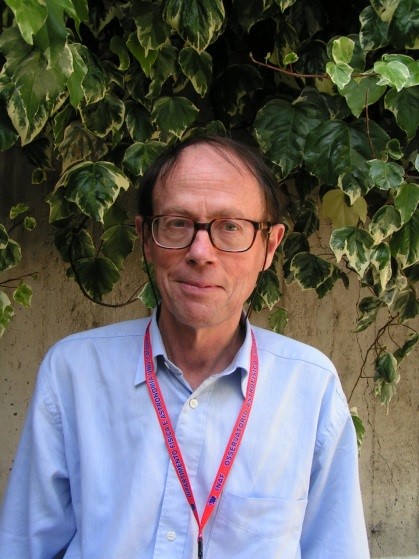 Malcolm Walmsley Photo courtesy of Prof. Karl Menten)
Malcolm Walmsley Photo courtesy of Prof. Karl Menten)
Charles Malcolm Walmsley
Contributed by T.L. Wilson and R. Wielebinski
Charles Malcolm Walmsley was born in Ranchi, India, on October 22, 1941, and died in Dublin, Ireland on May 1, 2017. In 1964 he graduated from Trinity College, Dublin. He continued his studies at the University of California, San Diego, completing a PhD in theoretical physics, specializing in the theory of extragalactic radio sources and planetary nebulae. He then took up a position at the Max-Planck-Institute for Radio Astronomy (MPIfR) in Bonn, Germany. Prof Walmsley spent the next 25 years in Bonn where his expertise provided the basis for success in applying molecular spectroscopy to investigations of the physical conditions in dense gas and the relation to star formation. Among many advances were his study of the interstellar chemistry of sources such as the Orion Molecular Cloud and the Taurus molecular Cloud. In the course of these studies, Prof Walmsley played an important role in advancing the science of molecular spectral line astronomy. This work included the prediction of the most intense methanol maser line. As a result, methanol masers become tracers of embedded high mass protostellar regions. Additional work included the study of inversion-rotation lines of the ammonia molecule to understand the excitation of this molecule, and its use as a tracer of kinetic temperature in interstellar clouds, and the establishment of the silicon monoxide molecule as a tracer of interstellar shock waves. Prof. Walmsley was recognized as an approachable, very friendly, helpful and inventive interpreter of molecular cloud data. He was a mentor of a number of students who later became leaders in this field. The most well-known is Prof Karl Menten, a director of the MPIfR.
In 1994, Walmsley was appointed to the position of full professor at the I. Physikalisches Institut in the University of Köln. In 1995, he moved to the Arcetri Observatory, Florence, where he retired in 2008. He was an editor of Astronomy & Astrophysics until 2014. In 2013 he took up the appointment as an honorary professor at the Dublin Institute of Advanced Study. Prof Walmsley's first wife, Collette, died in 1986; he married Prof Antonella Natta in 1992.
A lengthier account of Prof Walmsley's life and work is to be found in K. M. Menten and R. Cesaroni 2017 article in Nature Astronomy, Vol. 1, 01733.
Modified on Monday, 14-Feb-2022 13:27:43 EST by Ellen Bouton, Archivist (Questions or feedback)
|
![[IAU logo]](iau_wb_thumb.jpg)
![[URSI logo]](URSI-logo-thumb.jpg)
![[Karl Jansky at his antenna]](jansky_photo_02_thumb.jpg)
![[Reber's Wheaton antenna]](Reber_Telescope_Wheaton_thumb.jpg)
![[Dover Heights]](Dover_Heights_02_thumb.jpg)
![[4C telescope]](GB61-195_4C_telescope_thumb.jpg)
![[Ewen and horn antenna]](ewen_horn1s.jpg)
![[Dwingeloo, 1956]](Dwingeloo-1956-thumb.jpg)
![[Jocelyn Bell Burnell and Cambridge antenna used in pulsar discovery]](burnell2_thumb.jpg)
![[Lovell Telescope at Jodrell Bank]](site_1594_0001-500-334-20180316163019-thumb150.jpg)
![[Wilson, Penzias, and Bell Labs horn antenna]](wilson-penzias-horn_thumb.jpg)
![[6-m Millimeter Radio Telescope in Mitaka, Japan]](6m-thumb.jpg)

